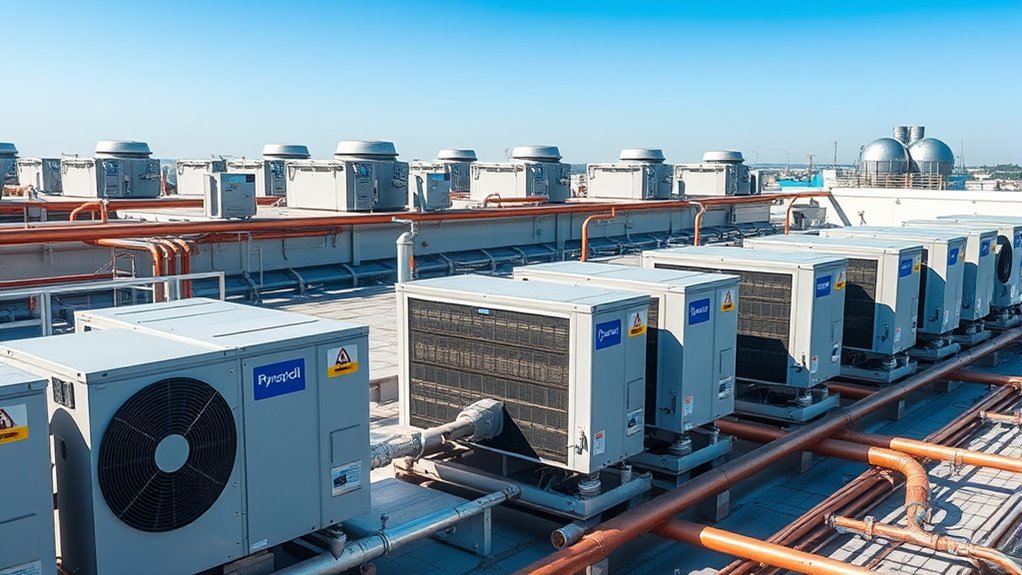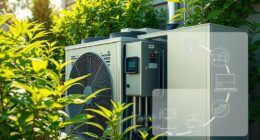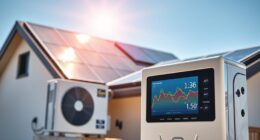VRF heat pump systems in commercial buildings offer flexible, energy-efficient climate control tailored to your needs. They connect multiple indoor units to a single outdoor unit, allowing you to heat or cool different zones simultaneously while saving energy. These systems are quiet, scalable, and support smart controls for better comfort and cost savings. While installation and maintenance require expertise, understanding these systems can help you maximize their benefits—keep exploring to learn more.
Key Takeaways
- VRF heat pump systems enable efficient heating and cooling by transferring heat between indoor and outdoor units in commercial buildings.
- They allow for customized zoning, providing precise climate control tailored to different areas.
- Modular and scalable, VRF systems support building expansion without major system overhauls.
- Advanced control integration enhances energy management and simplifies centralized operation.
- Proper installation and regular maintenance are essential to ensure system reliability and optimal performance.
How VRF Heat Pump Systems Operate in Commercial Settings
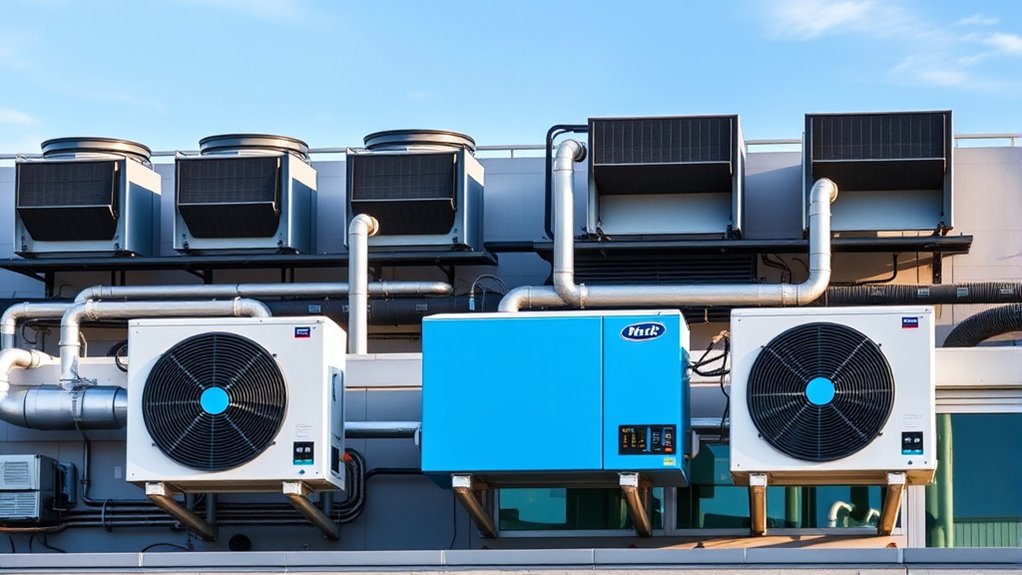
VRF heat pump systems operate efficiently in commercial settings by using multiple indoor units connected to a single outdoor unit. The system configuration allows you to customize heating and cooling in different zones, maximizing comfort and energy savings. Inside, the refrigerant cycle plays a vital role; it moves refrigerant between the outdoor and indoor units to transfer heat efficiently. When heating, the refrigerant absorbs heat from outside air and delivers it indoors, while in cooling mode, it releases heat outside. The system adjusts the refrigerant flow based on demand, maintaining ideal temperature control. This precise regulation ensures energy efficiency and comfort while minimizing operational costs. Additionally, the use of diverse designs in system components and configurations can further optimize indoor climate management and aesthetic integration. Understanding the system configuration and refrigerant cycle helps you appreciate how VRF systems deliver reliable, flexible climate management in commercial environments.
Key Benefits of Using VRF Technology in Commercial Buildings
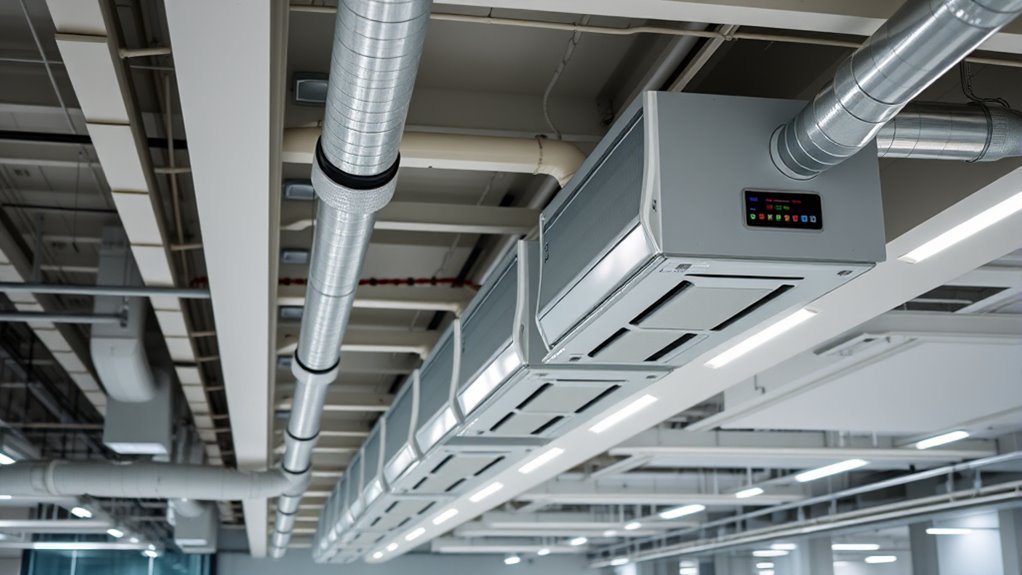
One of the primary advantages of using VRF technology in commercial buildings is its exceptional energy efficiency. It adapts cooling and heating to specific zones, reducing waste and lowering energy bills. With smart zoning, you gain precise control over individual areas, enhancing comfort and reducing unnecessary operation. VRF systems operate quietly, offering superior noise control that’s ideal for work environments or public spaces. Additionally, their modular design allows for scalable setups, supporting building growth without major disruptions. The ability to switch seamlessly between heating and cooling further optimizes energy use throughout the year. Modular design also enables easier system maintenance and upgrades, ensuring long-term performance and reliability. Overall, VRF technology provides a flexible, efficient, and quiet climate control solution, making it a smart investment for commercial buildings seeking sustainability and occupant comfort.
Design Considerations for Implementing VRF Systems

When planning to implement a VRF system, careful consideration of building size, layout, and load requirements is essential to guarantee ideal performance. Zoning strategies play a pivotal role in optimizing comfort and efficiency, allowing you to tailor heating and cooling to specific areas. Proper zoning minimizes energy waste and enhances system responsiveness. Additionally, control integration is fundamental; ensure that your VRF system seamlessly connects with building management systems for centralized operation and monitoring. This integration simplifies adjustments, improves diagnostics, and enhances overall system control. You should also evaluate the placement of indoor units and the capacity of the outdoor unit to match load demands accurately. Thoughtful design considering zoning and control integration will maximize your VRF system’s performance, comfort, and potential for future expansion. Incorporating aesthetic wall organization can further improve the visual appeal of mechanical spaces or areas where equipment is housed, contributing to overall building aesthetics.
Energy Efficiency and Cost Savings With VRF Heat Pumps
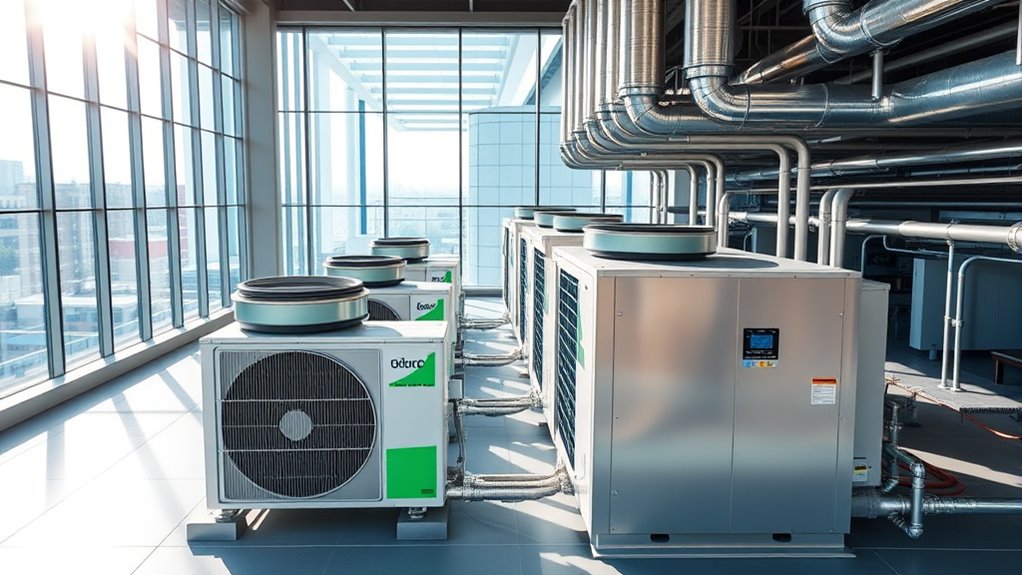
Implementing proper zoning and control strategies not only enhances comfort but also considerably boosts energy efficiency and cost savings. VRF heat pumps adapt to your building’s needs, reducing energy waste and lowering operating costs. By integrating smart controls, you can optimize system performance and respond to occupancy patterns in real time. This flexibility allows for better utilization of alternative energy sources, further decreasing reliance on traditional power. The result is an efficient system that cuts energy consumption and saves money over time. Additionally, advanced control systems enable precise temperature adjustments, minimizing unnecessary heating or cooling. These features work together to maximize savings while maintaining comfort. Incorporating AI-powered tools can further enhance system management by providing data-driven insights for ongoing optimization.
Challenges and Maintenance of VRF Systems in Commercial Environments

Despite their many benefits, VRF systems in commercial environments present specific challenges that require careful attention. One major concern is system reliability, as complex components must work seamlessly to prevent failures that disrupt comfort and efficiency. Installation complexities can also pose issues, often needing specialized knowledge and precise setup to guarantee peak performance. Regular maintenance is essential to address potential refrigerant leaks, clean filters, and check electrical connections, all of which influence system reliability. Additionally, educating your maintenance team on the intricacies of VRF technology helps prevent issues before they escalate. Proper planning, skilled installation, and consistent upkeep are critical to overcoming these challenges. Increased system complexity can sometimes lead to higher maintenance costs and require more detailed troubleshooting. While these challenges exist, proper planning, skilled installation, and consistent upkeep can maximize the benefits of VRF systems, keeping your commercial building comfortable and energy-efficient over time.
Frequently Asked Questions
How Do VRF Systems Integrate With Existing Building Automation Systems?
You can achieve seamless building automation by integrating VRF systems with your existing system integration platform. This process involves connecting the VRF controls to your building automation system, enabling centralized management of heating and cooling. By doing so, you optimize energy efficiency and enhance system performance. Make sure to verify compatibility and use open protocols to facilitate smooth communication, allowing you to monitor and control the VRF system alongside other building systems effortlessly.
What Are the Typical Lifespan and Warranty Options for VRF Heat Pumps?
You should know that VRF heat pumps typically last around 15 to 20 years, depending on usage and maintenance. Warranty coverage usually ranges from 5 to 12 years, offering protection for system durability and parts. Regular servicing can extend their lifespan. When choosing a system, check the warranty options carefully to make certain you’re covered against potential issues, helping you maximize your investment and maintain reliable performance over time.
Are VRF Systems Suitable for All Climates and Building Types?
Considering climate adaptability is like choosing the right shoes for a hike—you need the right fit. VRF systems are highly versatile, offering excellent building compatibility across diverse climates and building types. They efficiently adjust to varying temperatures, making them suitable for both hot and cold environments. However, it’s crucial to evaluate your specific climate and building needs to guarantee maximum performance and energy savings.
How Do VRF Systems Impact Indoor Air Quality and Ventilation?
You’ll find that indoor air quality improves with VRF systems because they enhance ventilation efficiency by providing precise temperature control and better air circulation. These systems often incorporate fresh air intake options, reducing indoor pollutants and maintaining healthier indoor air. As a result, you experience a more comfortable, cleaner environment, with improved air quality and ventilation that adapts to your building’s needs, promoting overall occupant well-being.
What Are the Environmental Impacts of Refrigerants Used in VRF Systems?
Think of refrigerants like fragile glass—if they leak, they can cause big problems. When refrigerant leaks happen, they contribute to global warming because many refrigerants are potent greenhouse gases. These leaks not only harm the environment but also deplete ozone layers. It’s essential to handle refrigerants carefully, minimize leaks, and choose environmentally friendly options to reduce the negative impact on our planet.
Conclusion
In the end, VRF heat pump systems prove to be a game-changer for your commercial building’s climate control, blending modern efficiency with the flexibility of a Swiss Army knife. While they demand some upkeep—think of it as tending your own flying car—they reward you with energy savings and reliable comfort. Embrace this technology now, because even in a world of jetpacks, smart HVAC solutions keep your building ahead of the curve, just like a well-tuned automaton.
